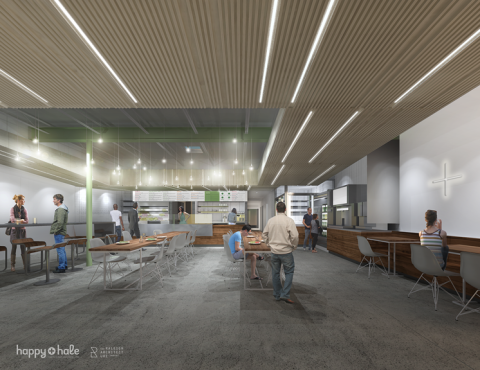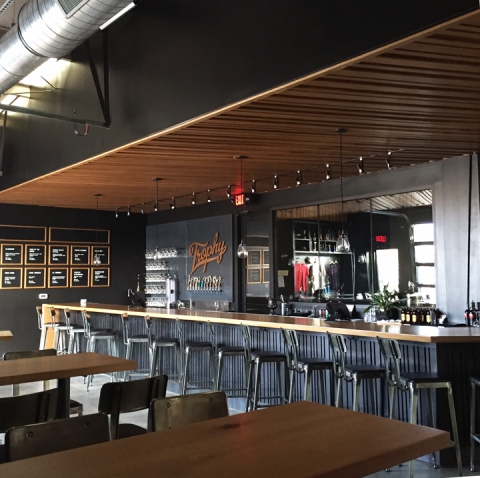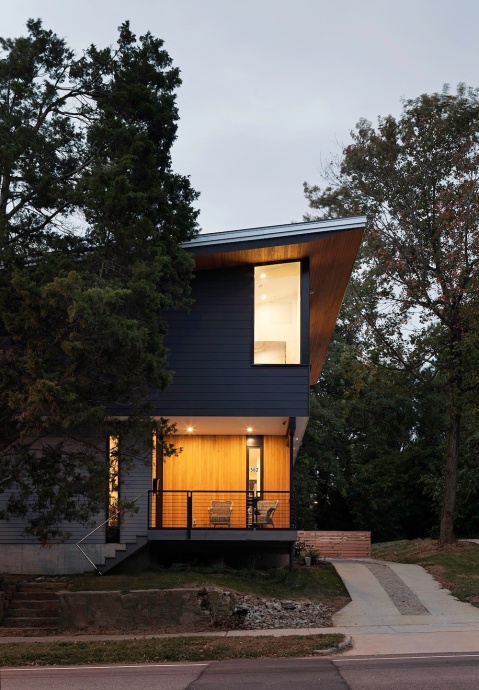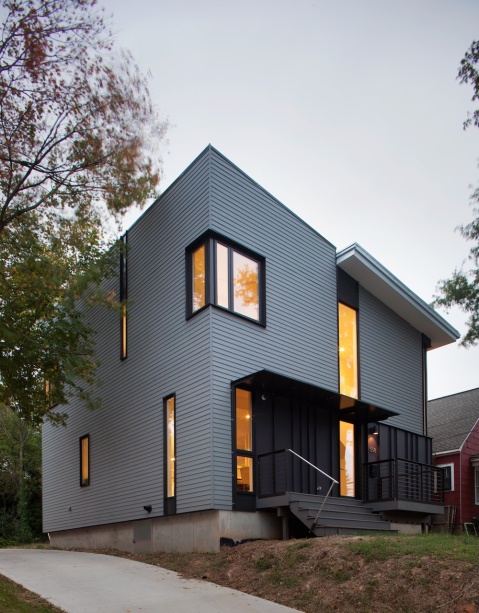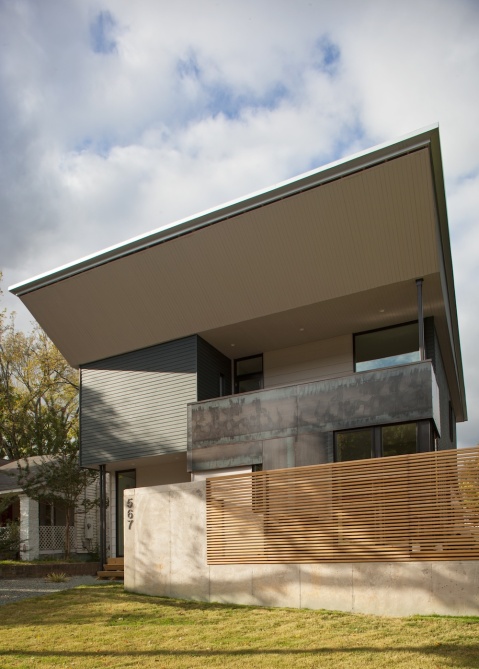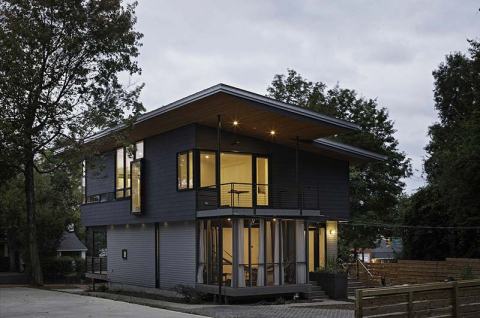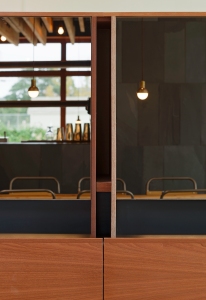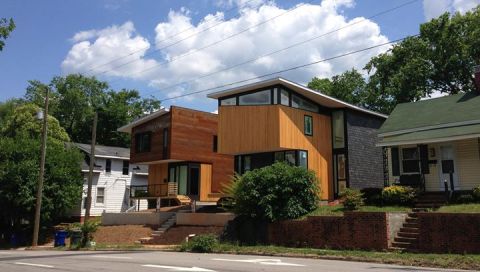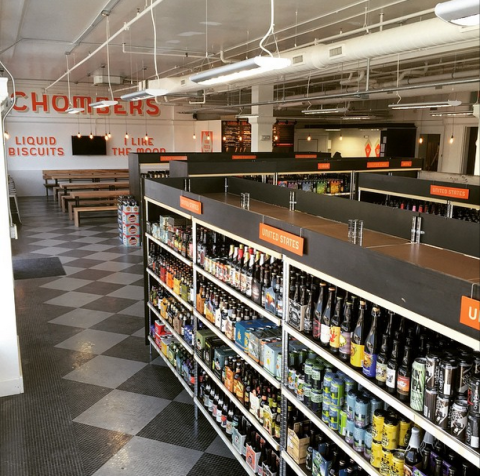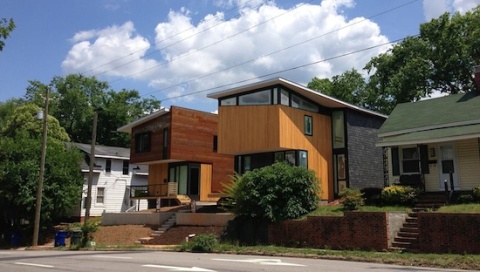Construction is Underway on Happy + Hale’s New Durham Location
January 25, 2016 § Leave a comment
Happy + Hale, a health-conscious restaurant concept with its flagship shop on Raleigh’s City Plaza, is expanding into Durham’s Ninth Street shopping and dining district, and The Raleigh Architecture Company (RACo) has designed the new addition to this growing business.
Currently under construction, the second Happy + Hale will fill 2000 square feet of a thoroughly renovated space within an existing building on Ninth Street. Yoga Off East will open behind it in 375 square feet.
Owned by Matt Whitley and Tyler Helikson, Happy + Hale is known for using only wholesome ingredients to prepare its fresh-pressed juices, salads, and wraps. To complement the restaurant’s concept, RACo partners Craig Kerins, AIA, and Robby Johnston, AIA, are using simple, honest materials for the physical space: concrete, wood, and open web steel trusses.
Steel trusses at the front of the space will give way to an overhead wood canopy with integrated lighting that will frame the large, open space for dining and gathering. Skylights provide natural light and views of the sky. Clustered pendant lighting will create a warm glow at the tables.
A walnut and stainless steel service bar will provide a “simple, linear ordering process for customers,” Johnston said. A wooden three-panel accordion door will open the interior to the exterior patio.
Within the space, a steel and glass storefront system will surround the “Juice Room” and allow customers to watch the staff prepare cold-press juices. During dinner and evening hours, a rotating menu of cocktails will be served using these fresh juices.
The restaurant’s kitchen will feature a central preparation table that will satisfy day-to-day needs and serve as a gathering point to promote food-based community outreach initiatives.
As Happy + Hale owner Tyler Helikson puts it, “This space represents the culmination of a dream,” said Helikson, “a place to connect, a place to create, a place to love, a place to empower.”
The Raleigh Construction Company, RACo’s construction partner, is building the new Happy + Hale, and expects it to be complete by this spring.
For more information on Happy + Hale, visit www.happyandhale.com.
For more information on The Raleigh Architecture Company, visit www.raleigh-architecture.com.
The Raleigh Architecture Co. Completes Trophy Brewing & Taproom
January 20, 2016 § Leave a comment
Transforming an existing warehouse into a state-of-the-art brewery operation.
The Raleigh Architecture Company (RACo) recently completed the design and construction of Trophy Brewing & Taproom at 656 Maywood Avenue in Raleigh following the success of the firm’s design for the smaller State of Beer bar and bottle shop that opened on Hillsborough Street in 2014.
For their new location, owners David Meeker, Chris Powers, David Lockwood, and Les Stewart asked RACo partners Craig Kerins, AIA, and Robby Johnston, AIA, to transform an existing steel-framed metal warehouse in a post-industrial area of the city into a 12,000-square-foot, 20-barrel production facility. The new facility includes an 8000-square-foot brewery fully visible from the 800-square-foot taproom, a barrel aging room, a keg cooler, office spaces, and a large outdoor patio.
In the brewery, three single-batch fermenters and three double-bath fermenters provide approximately 180 barrels of fermentation space. A reinforced foundation slab supports the weight of the equipment. The partners also had to enlarge the structure’s gas and water supply systems and install extensive floor drainage systems.
Continuous floor-to-ceiling storefront glazing provides a clear view inside the brewery from the taproom. The partners emphasized the visual connection with an angled furniture plan, a continuous solid white oak bar top between the taproom and brewery, and a custom-crafted white oak ceiling in the taproom, also applied on an angle.
According to Johnston, the exterior of the taproom is wrapped in natural white oak that folds into the taproom ceiling over the bar and in contrast with the room’s dark interior. Including the black-stained white oak bar base, the design scheme is “reminiscent of the exterior versus interior of wine and bourbon barrels used in the aging process: The exterior is left natural and the internal is charred to enhance flavor.” The natural and black-stained oak overlap at the 16-seat bar “where you experience the beer,” he added. The partners also specified metallic gold paint to recall the gold or bronze sheen of the facility’s namesake: trophy.
An aluminum-and-glass garage door and storefront glazing also make the brewery operation visible from the patio and the street.
Among other special features are polished concrete floors in taproom, a custom-designed terrazzo tap surround, and custom-designed steel water jet sleeves.
The architect of record for Trophy Brewing & Taproom is David Mauer with RACo serving as design architect and The Raleigh Construction Company as contractor.
For more information on The Raleigh Architecture Company, visit www.raleigh-architecture.com.
Three More Modern Houses Complete The Cluster In “Hungry Neck”
January 13, 2016 § Leave a comment
The Raleigh Architecture Co. adds new single-family homes to old urban neighborhood.
The Raleigh Architecture Company (RACo) has completed the final three houses in a cluster of modern, compact, single-family homes within the old “Hungry Neck” neighborhood just east of downtown Raleigh.
Each of the five urban-infill houses – including the original two on Edenton Street — is specific to the owners’ needs and lifestyle, yet they share certain design sensibilities. Each sits on a small buildable area on its lot. That plus tight zoning restrictions suggested compact linear footprints and projecting forms. Front porches, shaded by cantilevered second floors, link the homes to the community and reinforce the existing vernacular. Each house is sited on its lot to maintain the way other houses in this neighborhood address the sidewalk and street. All five houses are filled with an abundance of natural light.
The New Kids on the Block
A series of skylights and high glazing brings light and views into the central space of the new 2000-square-foot Kwon house (above), which happens to be a spacious, double-height kitchen. The owner is passionate about cooking and entertaining, so the dining space flows off from the kitchen and can extend outside on a covered deck. Large roof overhangs shade the windows and cover the balcony off the master bedroom suite upstairs.
For the 1770-square-foot Floyd house (above), two thin, double-height spaces connect the lower floor to the upper story on the northern and southern elevations. A thin shed roof creates a large overhang on the southern elevation and covers a walk out deck. In keeping with the owners’ desire for a clean, minimal interior, crisp white walls rise from blackened oak floors.
Privacy was a key component for the design of the Powers house (above), located on what was a vacant corner lot. A cast-in-place concrete wall adjoining the house creates a private courtyard that shields the house from the busy street nearby. Carefully arranged windows fill the interior with an abundance of natural daylight yet maintain the owners’ privacy. Inside and upstairs, a steel walkway, visible from a double-height space below, connects the two upper bedrooms.
All five houses feature concrete foundations, custom wood trusses, steel columns that allow large spans and spaces inside, high efficiency HVAC systems, European-style cabinetry, and solid oak floors.
For more information on the Hungry Neck houses and The Raleigh Architecture Company, visit www.raleigh-architecture.com.
ARCHITECTURE LAB: “Hungry Neck House / The Raleigh Architecture Company”
December 19, 2015 § Leave a comment
The Hungry Neck house home sits right in the middle of an old neighborhood in downtown Raleigh, NC, surrounded by busy thoroughfares and an assortment of frame houses from the 1930s and ‘40s.The thoroughfares suggested that the house “turn its back” on the street and focus on a huge, beautiful oak tree in the backyard. In the spirit of the neighborhood, however, a corner of the façade became a front porch overlooking the sidewalk. The owners, a young married couple, also enjoy the fact that their Modern house is helping to reinvigorate an old urban neighborhood that’s been overlooked for decades… READ MORE
Re-imagining The Neighborhood Grocery: The Raleigh Architecture Co. Completes Standard Foods
December 10, 2015 § Leave a comment
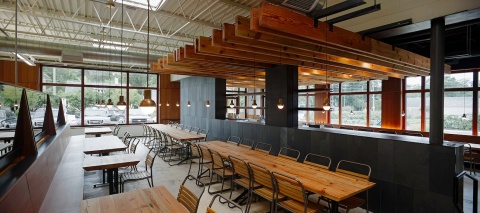
“The challenge was to create a design concept for the restaurant and bar that is reinforced by our selection of authentic and natural materials and honest detailing.” (Photos © Atlantic Archives)
When Standard Foods opened in downtown Raleigh’s Person Street Plaza this fall, owners John Holmes and Scott Crawford finally revealed their vision for an all-locally sourced, farm-to-table grocery store and restaurant, both of which celebrate “the food, farmers, and artisanal production methods of our region,” according to the website.
Within the Plaza, a redevelopment project that includes Raleigh City Farm, Yellow Dog Bakery, and other locally owned businesses, something else happened. Standard Foods’ physical space revealed The Raleigh Architecture Company’s interpretation of a shopping and dining experience that is at-once modern, urban, and artisanal.
A few months earlier, while the project was still under construction, John Holmes told the Independent Weekly, “We want the design to reflect what we’re trying to do with the food.” With that in mind, he and Crawford turned to Craig Kerins, AIA, and Robby Johnston, AIA, of The Raleigh Architecture Co (RACo), a local firm well known for custom retail designs and quality craftsmanship.
“The challenge,” Kerins said, “was to create a design concept for the restaurant and bar that is reinforced by our selection of authentic and natural materials and honest detailing.”
Ted Van Dyke of New City Design served as architect of record for the project with RACo as design architect for the front-of-the-house (areas open to the public) and the exterior.
Standard Foods is a 3000-square-foot grocery store, butcher shop, and 80-seat restaurant. The restaurant side features a 26-seat communal table and a 16-seat bar.
Outside, weathered steel slats trace the upper edge of the one-story, matte-charcoal exterior and provide shading for large windows that frame views of the Raleigh City Farm 20 yards away. Eventually the slats will also support plantings to add more shade and elements of the farm to the façade.
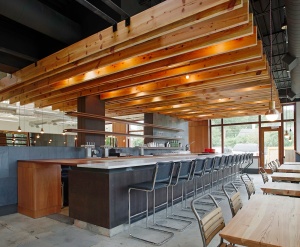
Part handcrafted, part sophisticated, the total design creates a distinctive identity for Standard Foods.
Inside, market and restaurant spaces flow into each other and the matte-charcoal reappears on background walls that enhance natural sapele wood and slate wall panels in the market, and heart pine tables and chairs in the restaurant. Metal refrigeration cases gleam under energy-efficient lighting, and accents of marble and leather add upscale elements to the simple, natural materials.
Part handcrafted, part sophisticated, the total design creates a distinctive identity for Standard Foods. Yet the colors and textures of the food – in the market or served on the tables – are the main attractions.
To ensure a community-oriented shopping experience, the aisles in the grocery store area are tight, reminiscent of an urban bodega. The spacing creates an intimate experience with the products. Benches between aisles encourage shoppers to linger.
“Most of us view grocery shopping as a chore,” observed architect Robby Johnston. “Our goal was to make this grocery store an experience – to give shoppers a feeling that’s fresh and friendly with an immediate perception of value.”
Standard Foods is a joint venture between Holmes, the president of real estate firm Hobby Properties, and Crawford, the former chef of Herons at The Umstead in Cary and twice a James Beard semifinalist for Best Chef in the Southeast. The men call their partnership The Nash Hospitality Group. For more information, go to standard-foods.com.
The Raleigh Architecture Co. is frequently commissioned for urban up-fits in existing buildings in downtown Raleigh. A few of the partners’ completed projects include Arrow Haircuts and NuvoNivo on Hargett Street, Runologie and State of Beer on Hillsborough Street, Trophy Brewing Company on Maywood Avenue and Crank Arm Brewing Company on West Davie Street. For more information, visit www.raleigh-architecture.com.
INHABITAT: “Two compact modern homes fill challenging empty lots in an old urban neighborhood”
November 13, 2015 § Leave a comment
By Kristine Lofgren
Two new compact houses introduce a modern, sustainable, infill-housing model to an old, urban neighborhood, while providing two young families with open, efficient homes perfectly suited to their individual lifestyles. Each home blends in with the neighborhood, but features a bevy of sustainable features, like locally-sourced recycled exterior materials, plenty of natural light and clever design that merges the interior of the homes with the world outside.
The homes were built to carefully blend into the neighborhood. For example, front porches have cantilevered second floors that cover the front porches are typical of every home in the old neighborhood, so these homes have the same feature. And because the houses were designed in tandem, the homeowners can share limited outdoor space between the two slim lots. The Raleigh Architecture Company (RACo), a design-build firm in Raleigh, NC, acted as developer, architect, contractor, and, for one house, owner. READ MORE…
The Raleigh Architecture Co. Hires New Project Manager
November 4, 2015 § Leave a comment
Craig Kerins, AIA, and Robby Johnston, AIA, partners in The Raleigh Architecture Company (RACo), announce that Claire Craven has joined the firm as a project manager.
Craven received her Bachelor of Architecture degree in 2012 from the University of Tennessee’s College of Architecture and Design, where she received a Faculty Design Award for the best design project of her graduating class. She also received an Exhibition of Undergraduate Research and Creative Achievement (EURēCA) Award was a member of Tau Sigma Delta, the architecture honor society. She graduated Summa Cum Laude.
Craven worked with Gray Organschi Architecture, a design-build office in New Haven, CT, before relocating to Raleigh and joining The Raleigh Architecture Co.
Her skills range from drawing in all design phases to project and construction management. She is also fluent in French and an accomplished graphic designer.
In addition to design, Claire’s interests include teaching, traveling, and working with “off-the-shelf materials because everything can be beautiful if treated thoughtfully.”
The Raleigh Architecture Company (RACo) is a full-service design-build-fabrication firm with its offices and workshop under one roof in Raleigh’s warehouse district. For more information, visit www.raleigh-architecture.com.
CURBED.com: “How Modern Style and Matching Buildings Re-Energized A Raleigh Neighborhood”
October 26, 2015 § Leave a comment
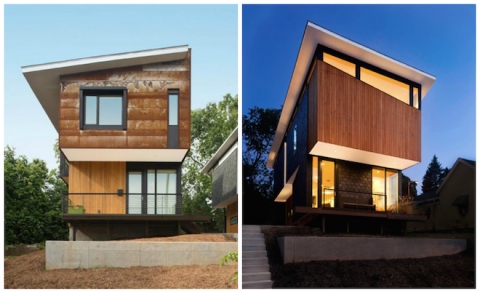
Developed as “fraternal twins,” the 554 and 556 Edenton homes by Raleigh Architecture Company share a common design language, but each have their own quirks. (All images via Raleigh Architecture Company Instagram.)
By Patrick Sisson 10.22.15
Instagram can be an endless font of inspirations and introductions, from new fashion concepts to undiscovered travel destinations. For architect Robby Johnston of The Raleigh Architecture Company, the visual app turned out to be a great way to find a new neighbor.
“A friend was house hunting a few years ago and posting images on Instagram, and as I clicked through, I found a couple doing the same thing nearby,” he says. “I looked at their account—they were well traveled, with interesting careers—and thought, ‘maybe they’re crazy enough to work with us.'”
Crazy isn’t always the operative word a homeowner uses when looking for a new neighbor, or the quality an architect seeks out when hunting for a new client. But then again, Johnston wasn’t a typical architect looking to sell a standard home. Along with partner Craig Kerins, Johnston was in the midst of developing a matching pair of modernist homes in Raleigh’s Hungry Neck neighborhood…READ MORE.
The Raleigh Architecture Co. Completes Second Tasty Beverage Beer Shop
October 21, 2015 § Leave a comment
Transforming a historic auto showroom in downtown Asheville.
(Raleigh, NC) — The Raleigh Architecture Company (RACo) recently completed the design of the Tasty Beverage bottle shop and tasting room in Asheville, NC, following on the success of the first Tasty Beverage that opened in Raleigh in 2011.
For his new shop in Western North Carolina, Johnny Belflower chose 4883 square feet on the first floor of the 1928 Conabeer Chrysler Building on Coxe Street, a three-story steel-frame building faced in orange brick and limestone. The first floor was the original auto showroom. The building was listed on the National Register of Historic Structures in 1979.
Keenly aware of the building’s historic significance, RACo partners Craig Kerins, AIA, and Robby Johnston, AIA, were careful to preserve key elements of the building’s interior shell – including copper-clad windows, plaster moldings, tiled floors – as they shaped it into Tasty Beverage.
“Simple, minimal detailing lets the old character of the building stay primary,” Kerins said of the open, spacious interior that features a small bar with 10 taps in one corner, plenty of additional seating at tables and benches, and an abundance of retail shelving.
Ashville’s Tasty Beverage joins several breweries within walking distance in the city’s South Slope district, an area of the city that’s come to be known as the Beer District. For more information, visit http://avl.tastybeverageco.com.
The Raleigh Architecture Co. has been involved with the design of several beer-centric establishments, including Crank Arm Brewing, State of Beer, and Trophy Brewing, all in Raleigh. For more information on RACo, visit http://www.raleigh-architecture.com.

